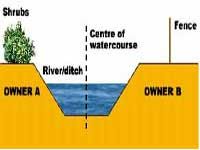Do you have a watercourse, such as a ditch, stream or river running through, or alongside, your property? If so, you are probably responsible for its maintenance and in legal terms you are a 'riparian owner'.
 Are you a riparian owner?
Are you a riparian owner?
If you have an ordinary watercourse or a main river running through your land or along the boundary of your property, you are likely to be the riparian owner or joint riparian owner; unless the watercourse is known to be owned by someone else. If the land on the other side of the watercourse is not in your ownership you are presumed to be the joint riparian owner together with the landowner on the other side. In the case of joint riparian ownership each party is presumed to own up to the centre line of the watercourse and therefore is responsible up to this point. If you are unsure whether you are the riparian owner of the watercourse running through your land, check the title deeds of your property.
Your rights
- To receive a flow of water in its natural state, without undue interference in quantity or quality;
- To protect your property against flooding from the watercourse and to prevent erosion of the watercourse banks or any nearby structures;
- You usually have the right to fish in your watercourse however you must use legal methods and may need a rod licence;
- Without an environmental permit, you can abstract a maximum of 20 cubic metres of water per day for the domestic purposes of your own household or for agricultural use (excluding spray irrigation). Most other types of abstraction will require a licence from the Environment Agency.
Your responsibilities
- You have the responsibility to pass on flow without obstruction, pollution or diversion affecting the rights of others;
- To maintain the banks and bed of the watercourse (including any trees and shrubs growing on the banks) and any flood defences that exist on it;
- To maintain any approved structures on your stretch of the watercourse. These may include culverts, trash screens, weirs and mill gates;
- You must not build a new structure (for example, a bridge or boardwalk) that encroaches upon the watercourse or alters the flow of water without first obtaining permission from Surrey County Council or the Environment Agency.
Further information
We have prepared some further information regarding frequently asked questions and some tips on maintaining your watercourse. There is also a factsheet which has more details about your rights and responsibility as a riparian owner and some further guidance for maintaining watercourses. These documents are available for download below.
If you have any further questions please contact us at flooding.enquiries@surreycc.gov.uk or phone the main Surrey County Council contact number.
A more detailed explanation of riparian issues can be found at the Environment Agency's website.
Implementation of legislation
To reduce the risk of flooding Surrey County Council is encouraging riparian owners to work towards an effective watercourse system through a process of co-operation, liaison, advice and assistance wherever possible. However, under the Land Drainage Act 1991 all Councils have the powers to serve notice on riparian owners, for the removal of any blockage to an ordinary watercourse. Should the riparian owner fail to do so, the Council has powers to undertake the work themselves and recharge the costs to the riparian owner. The Council will try to resolve problems through discussion with the owners in the first instance and enforcement of legislation will only be used as the last resort.
Your responsibilities as a riparian owner are based on the legislation below:
- The Public Health Act 1936
- The Land Drainage Acts 1991 and 1994
- Water Resources Act 1991
- Environment Agency Land Drainage Byelaws 1981
Files available to download
-
Riparian Ownership - Frequently Asked Questions (PDF)
Frequently asked questions regarding landowners responsibilities toward watercourses running through or adjacent to their land. -
Good Practice Guide for watercourse maintenance (PDF)
Introduction to maintaining your watercourse aimed at landowners and their agents.

